Mails.ai Alternatives
Searching for a Mails.ai alternative? This guide reviews 10 other platforms, comparing features and pricing to help you choose the right one.

You might be using Mails.ai for its strong cold outreach features. It performs well with email warmups and automation, offering unlimited inboxes and AI assistance. For many, it's a go-to for boosting campaign deliverability and getting results.
But no tool is perfect. Some users report a learning curve or find the navigation complex. This is why we've analyzed the best alternatives based on G2 reviews, comparing their strengths and weaknesses to help you decide. Let's get started.
Our Recommendation: 11x
Before the main comparison, consider 11x. If your sales team needs digital workers for outreach and lead generation, 11x offers a focused solution. The platform is built to manage specific sales tasks on its own.
11x is a GTM platform where AI agents manage the sales process. Alice finds prospects, conducts outreach on email and LinkedIn, and maintains the CRM. Julian qualifies inbound leads and books meetings. It replaces point solutions for data enrichment, outreach, and email warmup by unifying them.
Mails.ai Alternatives
This section reviews the main alternatives to Mails.ai. We compare each tool on pricing, features, and its specific advantages and drawbacks relative to Mails.ai.
1) Apollo.io
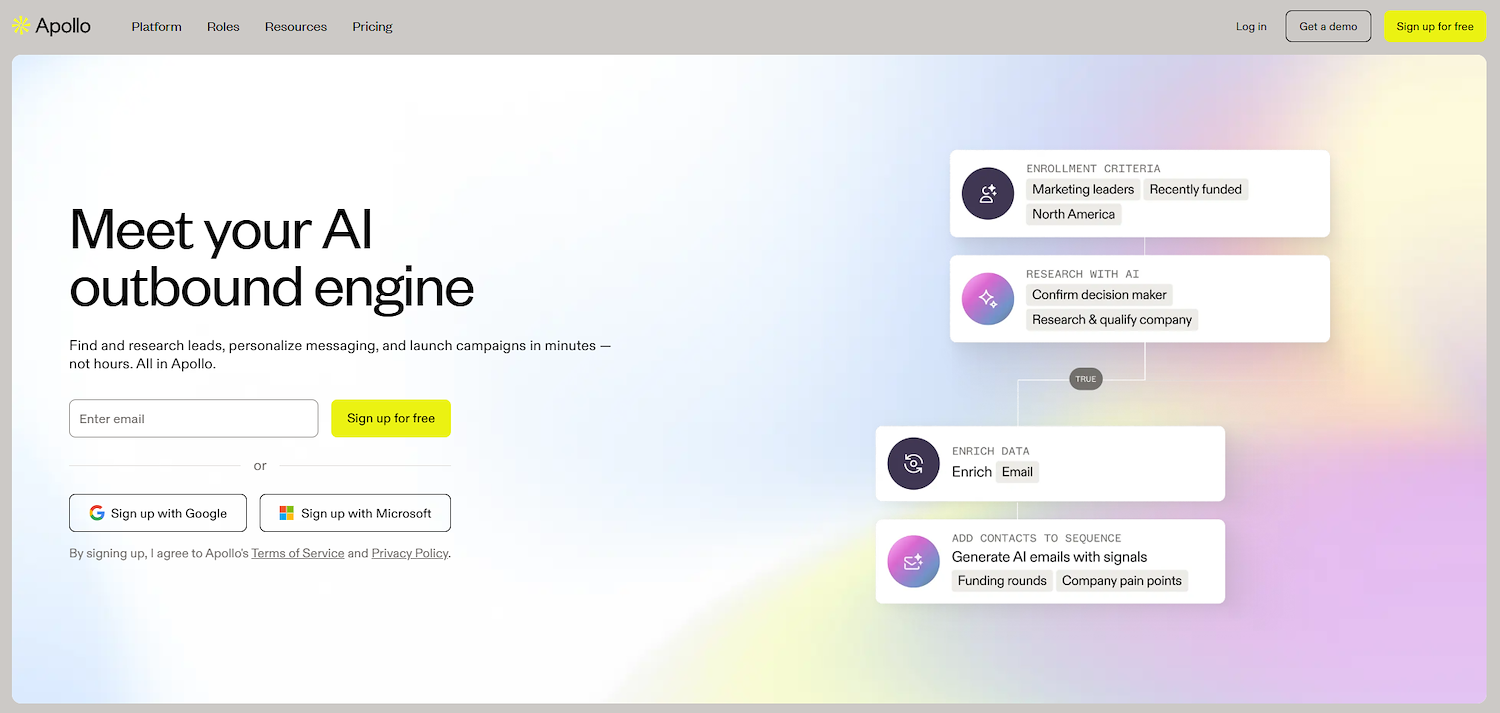
Apollo.io is a sales intelligence platform that provides a large contact database. Teams use it to find prospects and execute outreach with email sequences and calls. The system combines data with workflow tools to support the sales cycle and centralize prospect information and engagement activities.
Apollo.io's Main Features
- Provides access to a large contact database for prospect discovery.
- Executes outreach with email sequences and integrated calling features.
- Automates parts of the sales cycle with workflow tools.
- Centralizes prospect information and engagement activities for a unified view.
Apollo.io vs. Mails.ai: Key Differences
Average Review score: 4.7/5 stars based on 8,904 G2 reviews.
- Apollo.io provides a B2B database with over 210 million contacts. This is different from Mails.ai, which focuses on email outreach execution rather than providing prospect data.
- The platform combines sales intelligence, engagement, and workflow automation in one place. This contrasts with Mails.ai, which is a more specialized tool for email campaigns and warmup.
- It includes an integrated auto dialer and call tracking for direct outreach. This offers an additional communication channel compared to the email-centric approach of Mails.ai.
- This tool offers lead scoring and access to buyer intent data. These features allow for more precise targeting than the broader automation capabilities found in Mails.ai.
Apollo.io's Drawbacks Compared to Mails.ai
- Apollo.io lacks a specialized email warmup tool. This is different from Mails.ai, where this feature is a core part of its system to improve sender reputation from the start.
- Its user-based pricing can be a constraint for teams that need many inboxes. This contrasts with Mails.ai, which provides unlimited inboxes to better scale outreach campaigns.
- Some users report that its extensive features can create a steeper learning curve compared to a more focused tool. Mails.ai offers a more specialized experience centered only on email outreach.
Pricing and Cost-Effectiveness
Both platforms offer a free plan. Mails.ai’s paid plans start at $24 for its Startup tier, while Apollo.io’s entry-level Basic plan is $49 per user per month. This makes Mails.ai more cost-effective for basic outreach, whereas Apollo.io's price includes its large contact database.
2) Mailshake
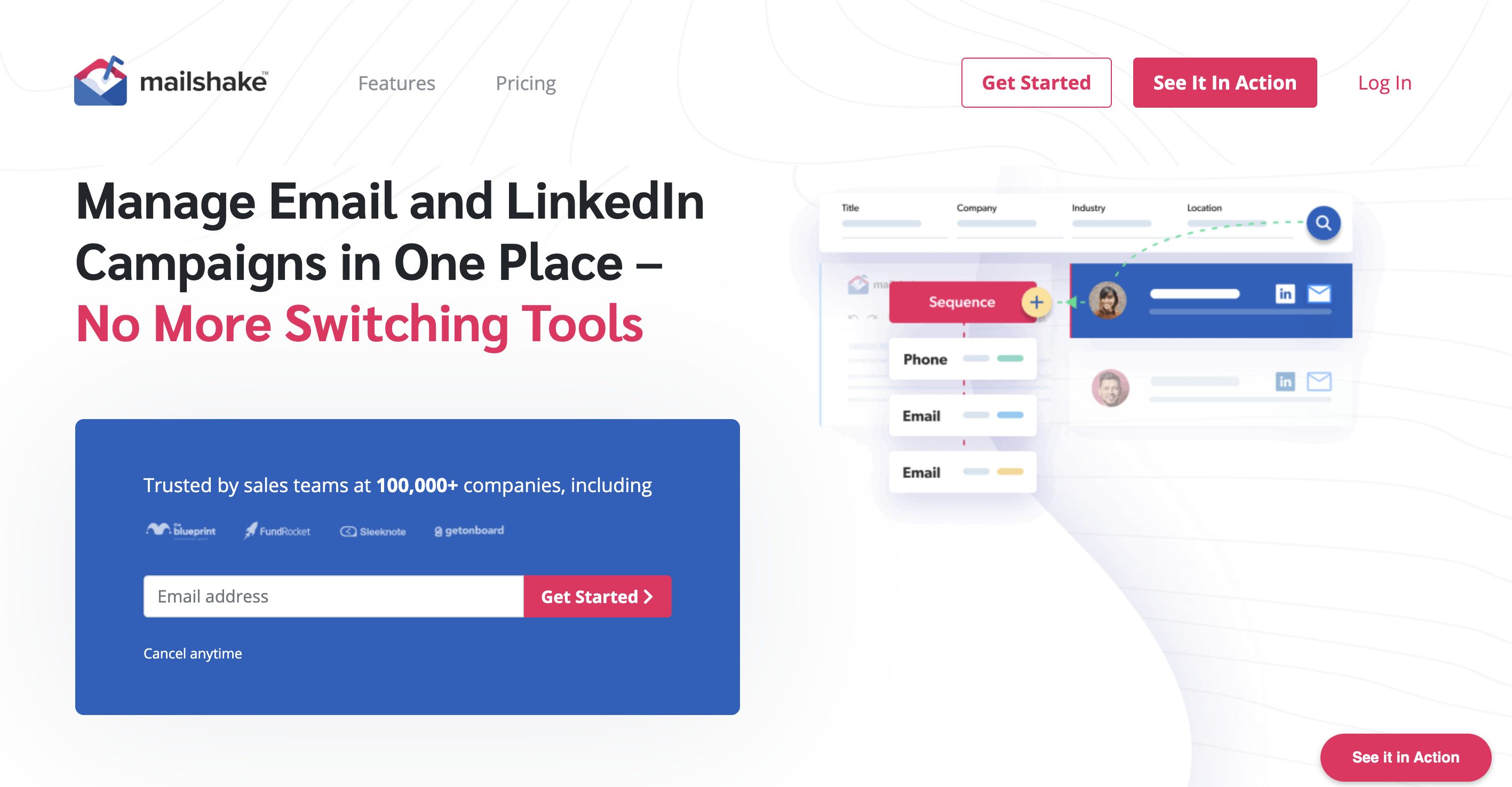
Mailshake is a sales-engagement platform for multi-channel outreach across email, phone, and LinkedIn. It helps teams connect with prospects and book meetings. The tool focuses on email deliverability, automated follow-ups, and AI-assisted content creation. Sales leaders use it to deploy sequences and monitor team analytics, while reps manage personalized outreach from a single dashboard.
Mailshake's Main Features
- Automates LinkedIn connection requests, profile views, and messages for multi-channel sequences.
- Offers a built-in database to search and purchase verified prospect email addresses.
- Includes a dialer to place cold calls directly from the platform as part of campaign steps.
- Uses a Lead Catcher to prioritize highly engaged prospects in a dedicated queue for quick action.
Mailshake vs. Mails.ai: Key Differences
Average Review score: 4.7/5 stars based on 326 G2 reviews.
- Mailshake supports outreach on phone and social media within a single sequence. This provides more communication channels than Mails.ai, which concentrates on email.
- It includes lead scoring to help teams prioritize prospects who show interest. This is a targeting feature not present in Mails.ai.
- The tool offers task management to organize follow-ups across different channels. In contrast, Mails.ai's workflow is built around email automation steps.
- Mailshake provides native integrations with CRMs like Salesforce and HubSpot. This creates a more unified sales process compared to Mails.ai, which focuses on email-specific functions.
Mailshake's Drawbacks Compared to Mails.ai
- Mailshake limits the number of mail accounts based on the pricing plan. This is different from Mails.ai, which offers unlimited inboxes to help scale large outreach campaigns without extra costs per account.
- It does not have a dedicated email warmup tool as a core function. Mails.ai includes this feature to help users build and maintain their sender reputation for better email deliverability.
- Some users report that campaign customization options can be limited. This may be a constraint compared to Mails.ai, which provides more specialized controls for email-focused automation and sequencing.
Pricing and Cost-Effectiveness
Mails.ai's paid plans start at $24 per month, while Mailshake's entry-level plan is $29 per month. Mails.ai offers unlimited mail accounts, making it more cost-effective for scaling outreach, whereas Mailshake's pricing is tied to the number of connected inboxes. For the most current details, check Mailshake's official website.
3) Lemlist
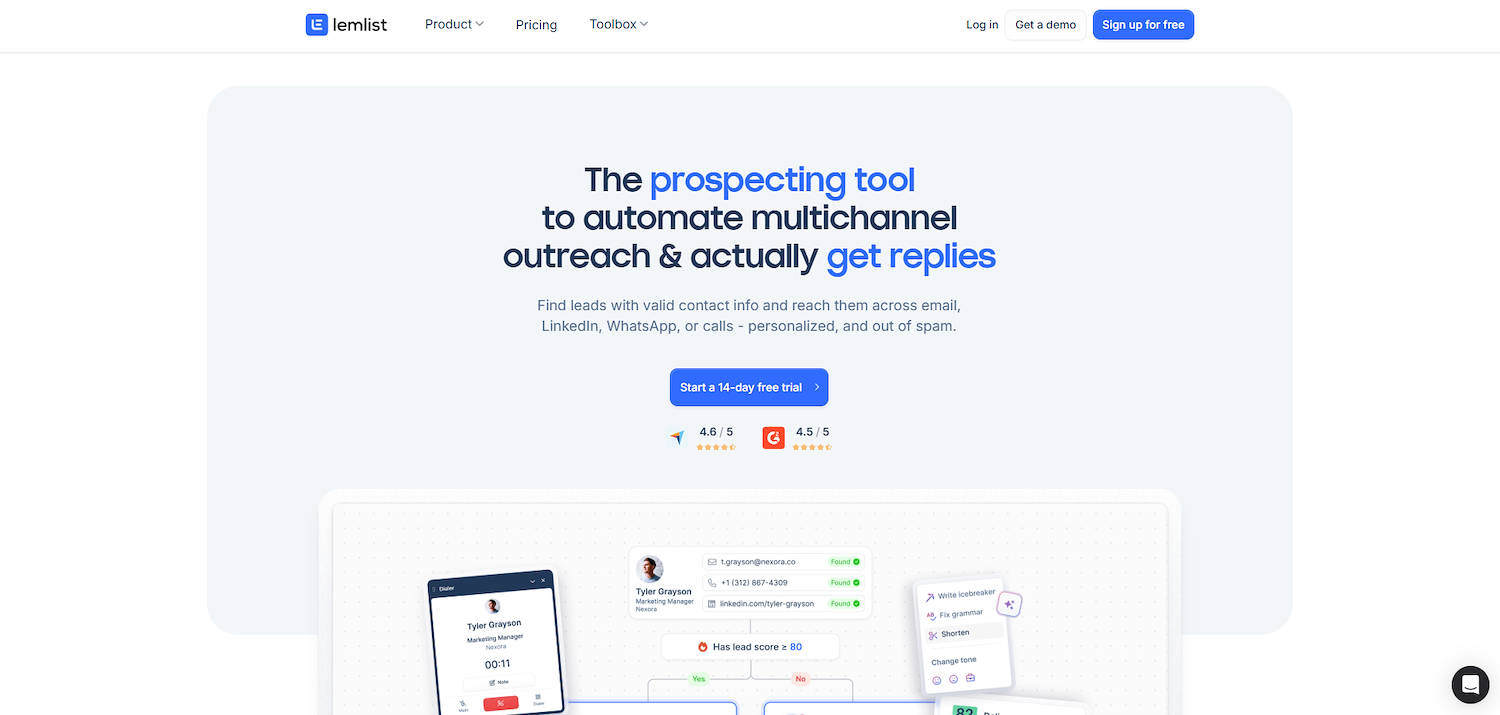
Lemlist is a sales-engagement platform for prospecting and outreach. It lets teams find and enrich leads from a 450M+ contact database. Users can automate multichannel sequences across email, LinkedIn, WhatsApp, and phone from one workspace.
The platform uses AI for message personalization and includes the lemwarm tool to maintain deliverability. The system helps build targeted lead lists and launch outbound campaigns to get replies from prospects.
Lemlist's Main Features
- Provides access to a 450M+ B2B contact database with advanced filters and one-click enrichment for verified emails and phone numbers.
- Automates multichannel sequences across email, LinkedIn actions, WhatsApp messages, and calls from a unified inbox.
- Uses AI to scrape LinkedIn and websites to auto-insert fresh insights for message personalization.
- Includes the lemwarm tool with each seat to warm up inboxes and protect sender reputation.
Lemlist vs. Mails.ai: Key Differences
Average Review score: 4.4/5 stars based on 276 G2 reviews.
- Lemlist combines email, LinkedIn, WhatsApp, and phone calls in a single sequence, offering more ways to contact prospects than Mails.ai's email-centric platform.
- It provides a database of over 450 million B2B contacts for lead generation, a feature Mails.ai does not include.
- The platform uses AI to pull fresh information from LinkedIn and websites for message personalization, a more specific function than Mails.ai's general AI assistance.
- A built-in dialer allows users to make calls as part of their outreach campaigns, adding a communication channel that Mails.ai lacks.
Lemlist's Drawbacks Compared to Mails.ai
- Lemlist's per-user pricing model might increase costs for teams that need many seats. This is different from Mails.ai, which provides unlimited inboxes and can be more cost-effective for large outreach operations.
- The tool's all-in-one approach, which includes multiple channels, can sometimes make the interface feel complex for users. Mails.ai offers a more specialized experience focused only on email outreach.
- Some users report occasional technical issues, particularly with data enrichment, which can disrupt prospect workflows. Mails.ai's focused design may offer more stability for its core email functions.
Pricing and Cost-Effectiveness
Mails.ai's paid plans start at $24 per month, while Lemlist's entry-level paid plan is $55 per year. Lemlist's multichannel plan is $79 per month, compared to Mails.ai's $49 Growth plan, reflecting its broader feature set. For current pricing, visit Lemlist's official website.
4) Outreach
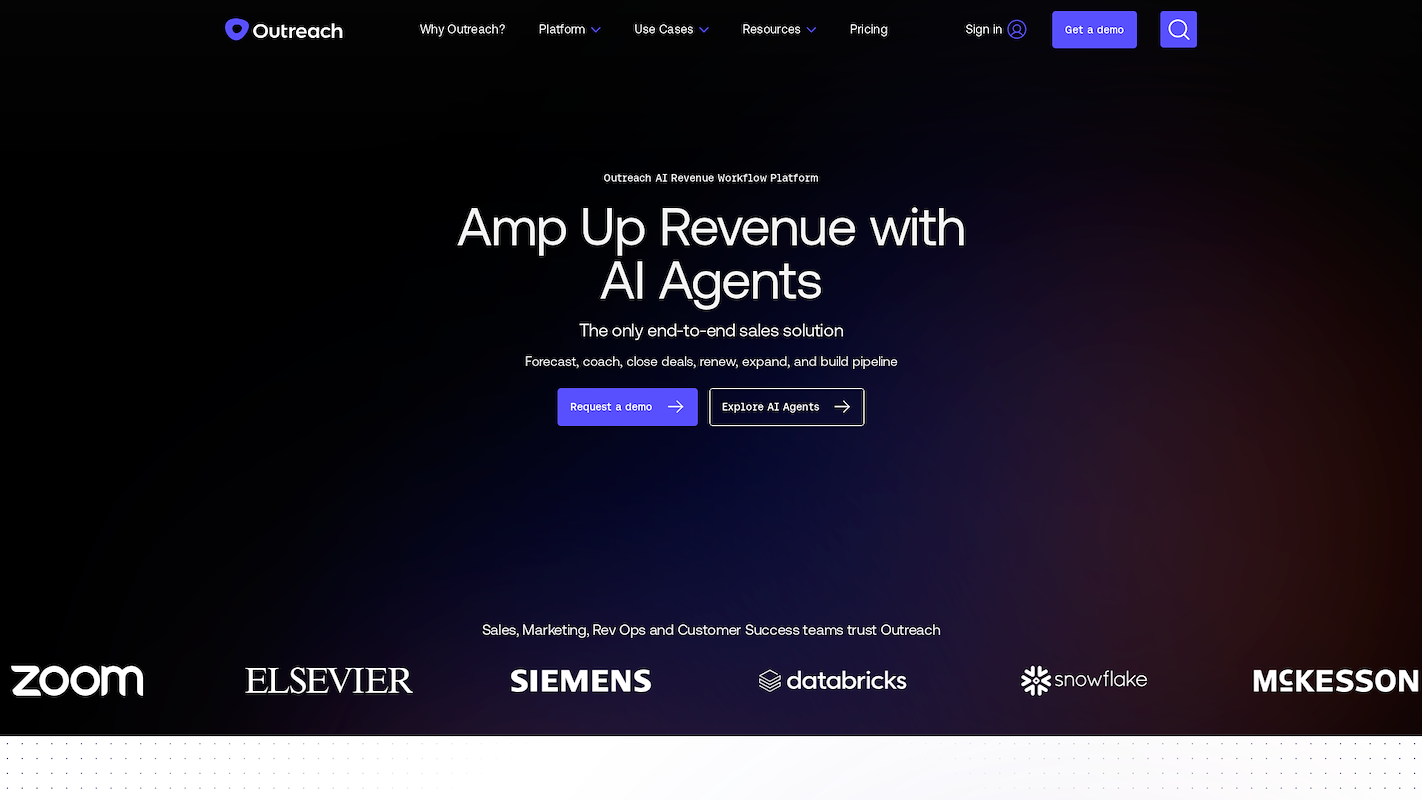
Outreach is a sales execution platform for revenue teams. It offers tools to manage the full sales cycle, from prospect contact to deal closure. The system supports email outreach and provides analytics to measure sales activities. It helps organizations standardize their sales process and improve rep productivity.
Outreach's Main Features
- Uses pipeline and forecast analytics to predict revenue outcomes and identify gaps.
- Provides AI-driven coaching with meeting summaries and performance analytics through its Kaia tool.
- Detects buyer sentiment and topics across meetings, calls, and emails.
- Offers a Smart Deal Assist feature to surface risks and next steps for active deals.
Outreach vs. Mails.ai: Key Differences
Average Review score: 4.3/5 stars based on 3,479 G2 reviews.
- Outreach offers a full sales execution platform for the entire sales cycle, including deal management and forecasting. This scope is broader than Mails.ai, which focuses specifically on email outreach.
- The platform provides AI-driven sales coaching and conversation intelligence. This offers deeper performance analytics than the AI assistance for email writing found in Mails.ai.
- It includes revenue intelligence tools for pipeline and forecast analytics to help predict sales outcomes. This is a feature Mails.ai does not offer, as its analytics focus on email campaign metrics.
- This tool offers a Smart Deal Assist feature to manage active deals by identifying risks and next steps. This function supports the closing stage of a sale, which is beyond the scope of Mails.ai's email campaign focus.
Outreach's Drawbacks Compared to Mails.ai
- Outreach does not offer a built-in email warmup tool. This can be a disadvantage for users who need to build sender reputation, a process that Mails.ai automates with its core features.
- Its pricing is often based on a per-user model. This can be less cost-effective for large teams compared to Mails.ai, which allows for unlimited inboxes to support broader campaign scaling.
- Some users find that the platform's extensive features can make it complex to navigate. This contrasts with Mails.ai, which provides a more focused user experience centered only on email outreach.
Pricing and Cost-Effectiveness
Mails.ai offers paid plans starting at $24 per month. Outreach does not list its prices publicly, but user reviews indicate a high perceived cost, positioning it as an enterprise solution. For accurate pricing, we recommend visiting Outreach's official website.
5) Reply.io
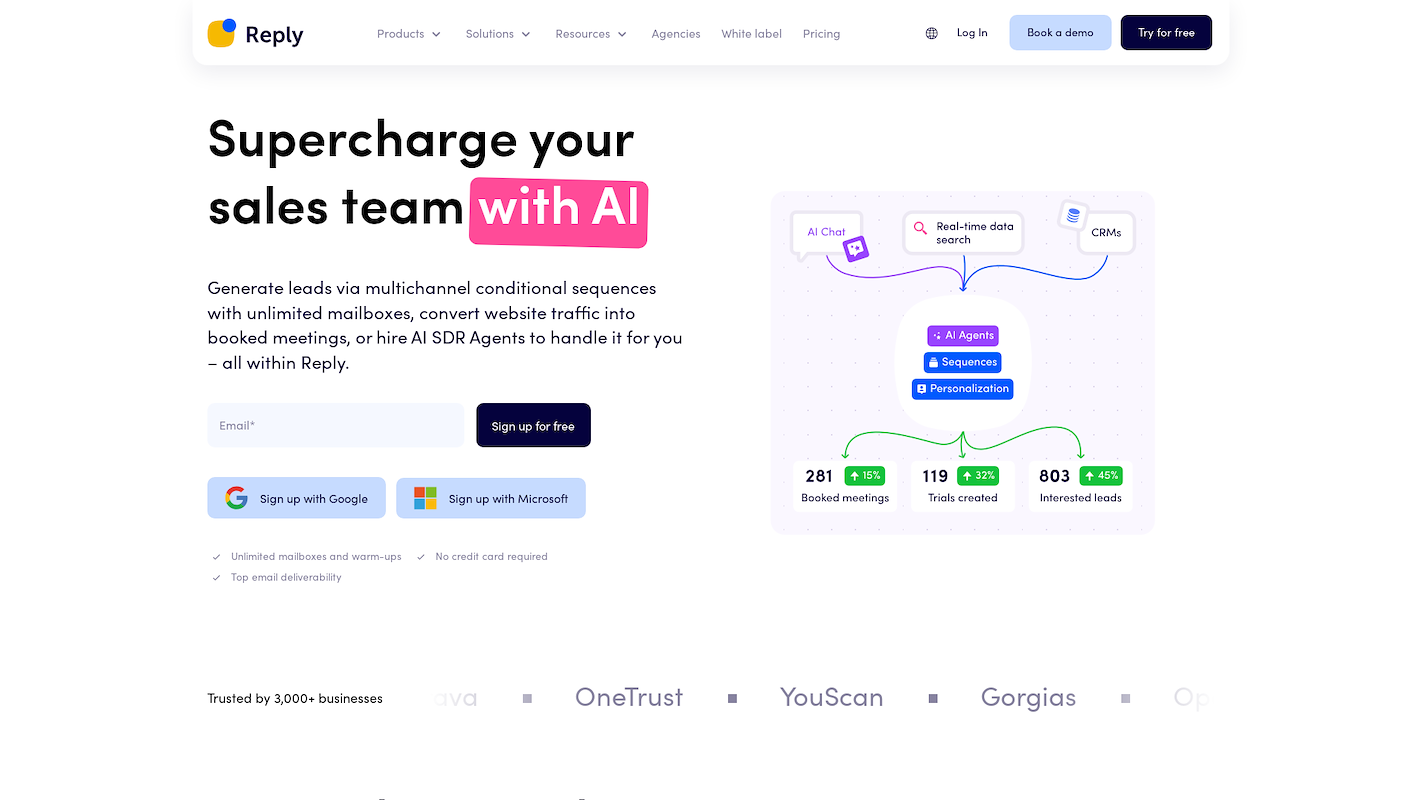
Reply.io is a sales engagement platform for multichannel outreach. It helps teams connect with prospects through email, LinkedIn, calls, and SMS. The system automates sequences and includes tools to schedule appointments.
It also offers a B2B contact database to find and verify leads. Sales teams use it to manage their outreach and book meetings from a single interface.
Reply.io's Main Features
- Hires an autonomous SDR agent, Jason AI, to research contacts, write messages, and book meetings.
- Combines email, LinkedIn, calls, SMS, and WhatsApp into multichannel conditional sequences.
- Provides access to a B2B database of over 1 billion contacts, with 50 live data credits included per month in most plans.
- Uses AI variables for paragraph-level personalization, rewriting each email uniquely at scale.
Reply.io vs. Mails.ai: Key Differences
Average Review score: 4.6/5 stars based on 1,458 G2 reviews.
- Reply.io offers an autonomous AI agent that manages outreach and books meetings. This is a more advanced function compared to Mails.ai, where AI assists with content creation.
- The platform supports multichannel outreach, with calls, SMS, and WhatsApp in its sequences. This provides more contact options than the email-focused approach of Mails.ai.
- It uses AI to rewrite entire paragraphs for personalization in each email. This offers a deeper level of unique content creation than the general AI help in Mails.ai.
- The tool includes an AI chat feature for websites that engages visitors and books meetings. Mails.ai does not have a comparable feature for lead capture on a user's site.
Reply.io's Drawbacks Compared to Mails.ai
- Reply.io provides email warmup through an integration with Mailtoaster.ai. This differs from Mails.ai, where the warmup tool is a core, built-in function of the platform.
- The platform uses a per-user pricing model, which can be costly for large teams. In comparison, Mails.ai offers unlimited inboxes, making it a more scalable option for some users.
- Some users may find its multichannel system complex if they only need email outreach. Mails.ai provides a more focused experience, which can be simpler for teams that specialize in email campaigns.
Pricing and Cost-Effectiveness
Both platforms offer a free plan. Mails.ai's paid plans start at $24 per month, while Reply.io's entry-level paid plan is $49 per user per month. Mails.ai's flat-fee model is more cost-effective for scaling with unlimited inboxes, while Reply.io's per-user cost covers its advanced multichannel and AI features.
Why We Recommend 11x for Sales
If your goal is to automate specific sales tasks, consider 11x. The platform provides digital workers that manage parts of the sales process independently. This approach differs from tools that only assist human reps with outreach.
For teams that want to delegate prospecting, outreach, and lead qualification to AI, 11x offers a focused solution. Explore how its AI agents, Alice and Julian, handle these sales responsibilities on the 11x platform.
With 11x, AI manages your sales process. Alice identifies accounts, enriches contact data, and handles outreach. Julian qualifies inbound leads and books meetings. The platform unifies tools for intent data and email warmup, removing the need for separate point solutions.
Book a demo to see the platform in action.
6) Salesloft
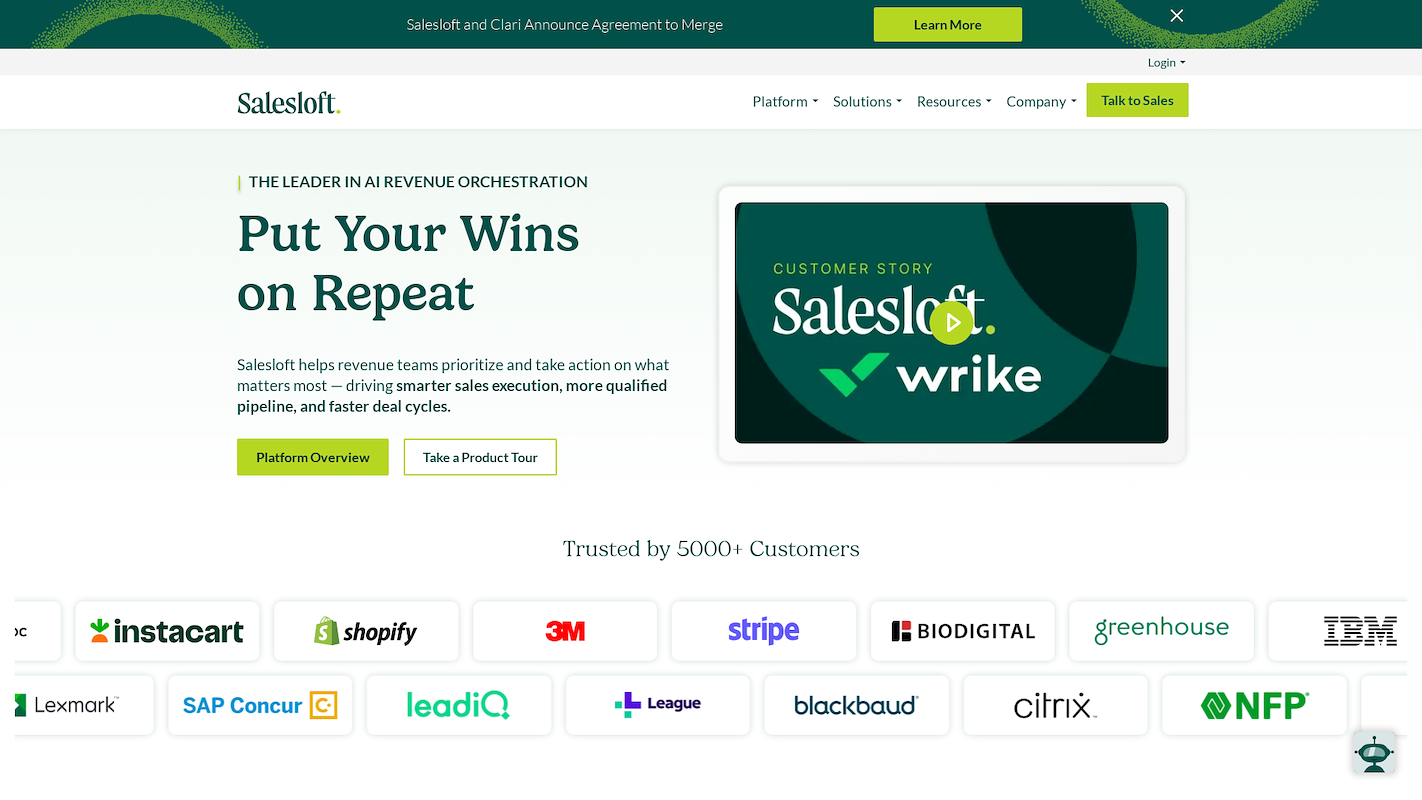
Salesloft is a sales engagement platform for revenue teams to manage the sales cycle. It helps sellers execute multichannel outreach via email, calls, and social media. The system uses structured workflows, called Cadences, to guide activities and provides analytics to measure performance and forecast outcomes.
Salesloft's Main Features
- Uses structured workflows, called Cadences, to automate and guide pipeline creation, lead nurture, and renewals.
- Provides AI-driven prioritization through its Rhythm feature, which recommends specific actions for sellers at the right moments.
- Offers a Deals module for pipeline and deal management with AI insights into risk, next steps, and velocity.
- Includes conversation intelligence to analyze recorded calls for buyer and seller insights to improve performance and coach reps.
Salesloft vs. Mails.ai: Key Differences
Average Review score: 4.5/5 stars based on 4,145 G2 reviews.
- Salesloft provides a full revenue platform for the entire sales cycle, including deal management. This is different from Mails.ai, which focuses specifically on email outreach.
- It includes conversation intelligence to analyze calls and provide AI-driven coaching. This offers deeper performance analytics compared to the AI writing assistance in Mails.ai.
- The platform uses a feature called Rhythm to guide sellers with AI-prioritized actions. In contrast, Mails.ai automation is built to execute email sequences.
- This tool offers a Deals module for pipeline management and forecasting. Mails.ai does not have a comparable feature, as its analytics focus on email campaign metrics.
Salesloft's Drawbacks Compared to Mails.ai
- Salesloft does not have a native email warmup function. This is different from Mails.ai, which includes this tool as a standard feature to help maintain sender reputation.
- The tool's pricing is on a per-user basis, which can increase costs for larger teams. In contrast, Mails.ai provides unlimited inboxes, offering a more scalable option for some outreach operations.
- Its comprehensive feature set sometimes creates a complex user experience. Mails.ai provides a more specialized platform focused only on email, which can be simpler for teams with that specific need.
Pricing and Cost-Effectiveness
Mails.ai offers transparent pricing with paid plans starting at $24 per month. In contrast, Salesloft does not list its prices publicly, positioning it as an enterprise solution with a higher perceived cost. For the most accurate and up-to-date pricing information, we recommend visiting Salesloft's official website.
7) Woodpecker.co
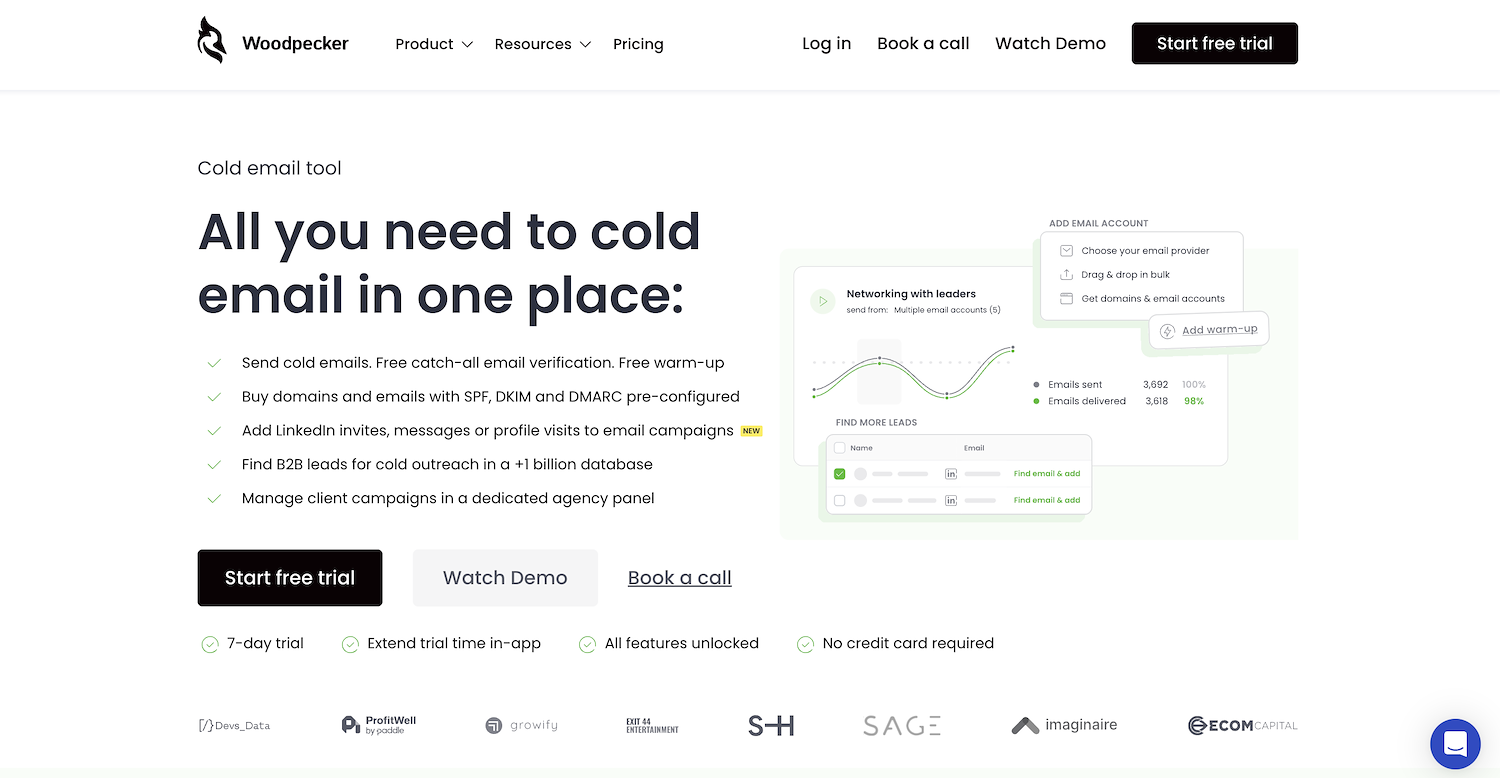
Woodpecker.co is a cold email tool for lead generation, sales, and recruitment professionals. The platform automates the dispatch of emails and follow-ups to prospects from a single interface.
It allows teams to manage contacts and track campaign performance. Common applications for the tool are sales outreach, link building, and public relations.
Woodpecker.co's Main Features
- Includes built-in deliverability safeguards, such as free email verification, warm-up, and adaptive sending, to protect sender reputation.
- Uses condition-based logic to build multistep campaigns that guide prospects down different paths based on their actions.
- Integrates LinkedIn outreach steps, including connection invites and messages, directly into campaign sequences.
- Provides a dedicated agency panel to manage multiple client campaigns from a single dashboard.
Woodpecker.co vs. Mails.ai: Key Differences
Average Review score: 4.5/5 stars based on 93 G2 reviews.
- Woodpecker.co uses condition-based logic to guide prospects down different campaign paths based on their actions. This offers more advanced automation compared to the standard sequences in Mails.ai.
- It provides a dedicated agency panel to manage multiple client campaigns from a single dashboard, a feature not available in Mails.ai.
- The platform includes built-in email verification and a "Bounce Shield" to protect sender reputation. These are more specific deliverability tools than Mails.ai's core warmup feature.
- This tool integrates LinkedIn outreach steps, such as connection invites, directly into its sequences. This adds a social media channel that Mails.ai does not support.
Woodpecker.co's Drawbacks Compared to Mails.ai
- Woodpecker.co bases its pricing on the number of contacted prospects, with its starting plan limiting users to 500 contacts per month. This model can be a constraint for teams with large lists, unlike Mails.ai, which may offer different scaling options.
- The tool includes features for agencies and multichannel outreach. This might add complexity for users who need only simple email automation, in contrast to the focused design of Mails.ai.
- Some users report that its integrations can be limited. This may be a factor for teams that need a solid connection to a specific CRM, where Mails.ai's specialized focus could offer a more direct integration experience.
Pricing and Cost-Effectiveness
Mails.ai offers paid plans starting at $24 per month, while Woodpecker.co begins at $29 per month for up to 500 contacted prospects. This makes Mails.ai more cost-effective for large-scale outreach, whereas Woodpecker.co's model may suit smaller campaigns. For current pricing, visit Woodpecker.co's official website.
8) Instantly.ai
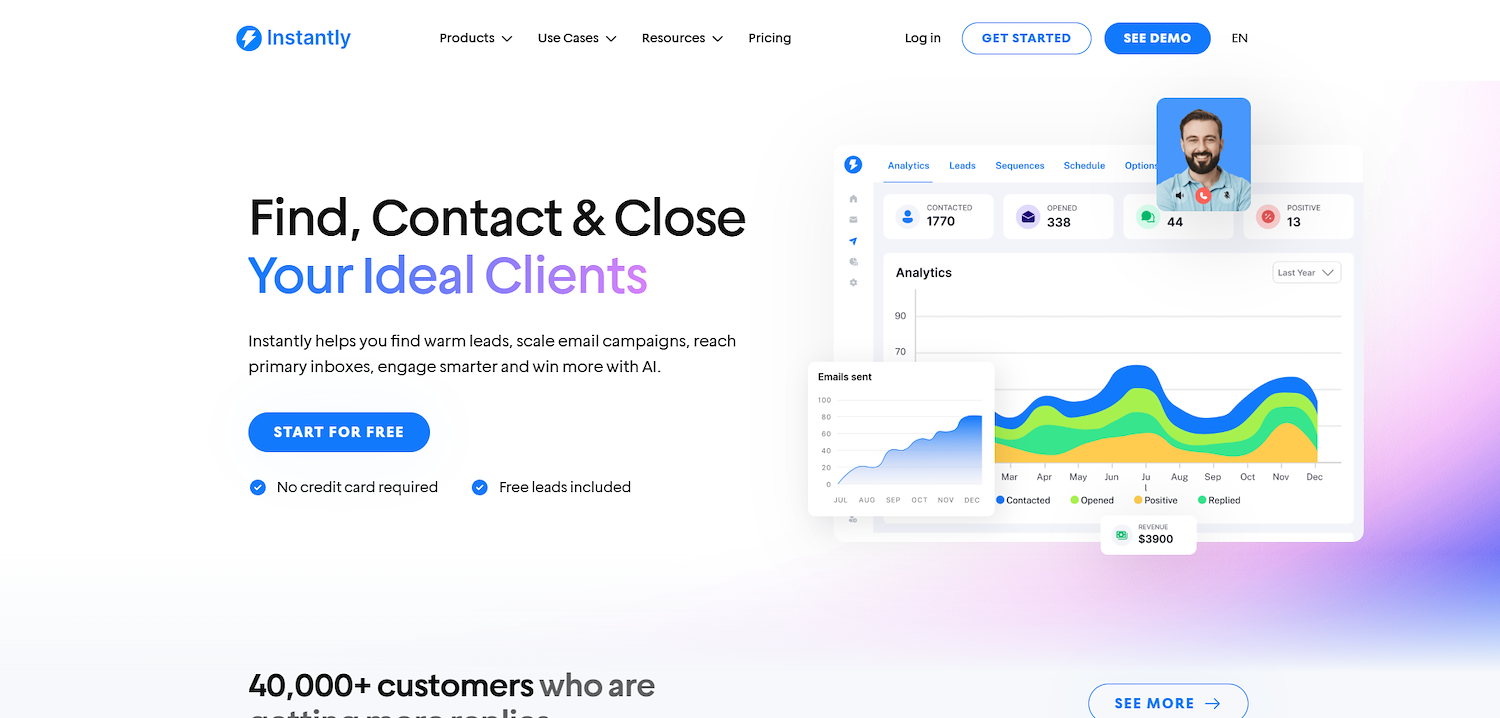
Instantly.ai is a cold email platform built for outreach at scale. It supports unlimited email accounts and includes a warmup tool to maintain deliverability. Users can automate email sequences to manage lead generation and sales campaigns.
Instantly.ai's Main Features
- Provides A/B testing to compare different email versions for better results.
- Includes an email and mobile preview to check campaign appearance across devices.
- Offers integration APIs to build custom connections with other tools.
- Supports high-volume sending to manage large-scale outreach campaigns.
Instantly.ai vs. Mails.ai: Key Differences
Average Review score: 4.8/5 stars based on 3,721 G2 reviews.
- Instantly.ai includes a B2B lead database for finding prospects. This is different from Mails.ai, which focuses on outreach execution rather than providing contact data.
- The platform offers A/B testing to compare different email versions. This provides a specific way to optimize campaigns, in contrast to the general automation features in Mails.ai.
- It provides an email and mobile preview feature. This allows users to check how campaigns look on different devices, a specific function not detailed for Mails.ai.
- This tool offers integration APIs to build custom connections with other software. This gives more flexibility than the more focused email functions of Mails.ai.
Instantly.ai's Drawbacks Compared to Mails.ai
- Instantly.ai's tiered pricing model can be more expensive for teams that need advanced features. This is different from Mails.ai, which has a lower starting price.
- The tool's reporting features may offer limited options for deep customization. In contrast, Mails.ai provides analytics specifically tailored to email campaign performance, which might be more direct.
- Some users note the interface can slow down when they manage very large lists. Mails.ai's specialized platform may provide more consistent performance for its main tasks.
Pricing and Cost-Effectiveness
Mails.ai offers a lower starting price at $24 per month, while Instantly.ai's paid plans begin at $37 per month. The price difference reflects their focus, with Mails.ai being more cost-effective for core email outreach and Instantly.ai's higher tiers including a broader feature set. For current pricing, visit Instantly.ai's official website.
9) Smartlead.ai
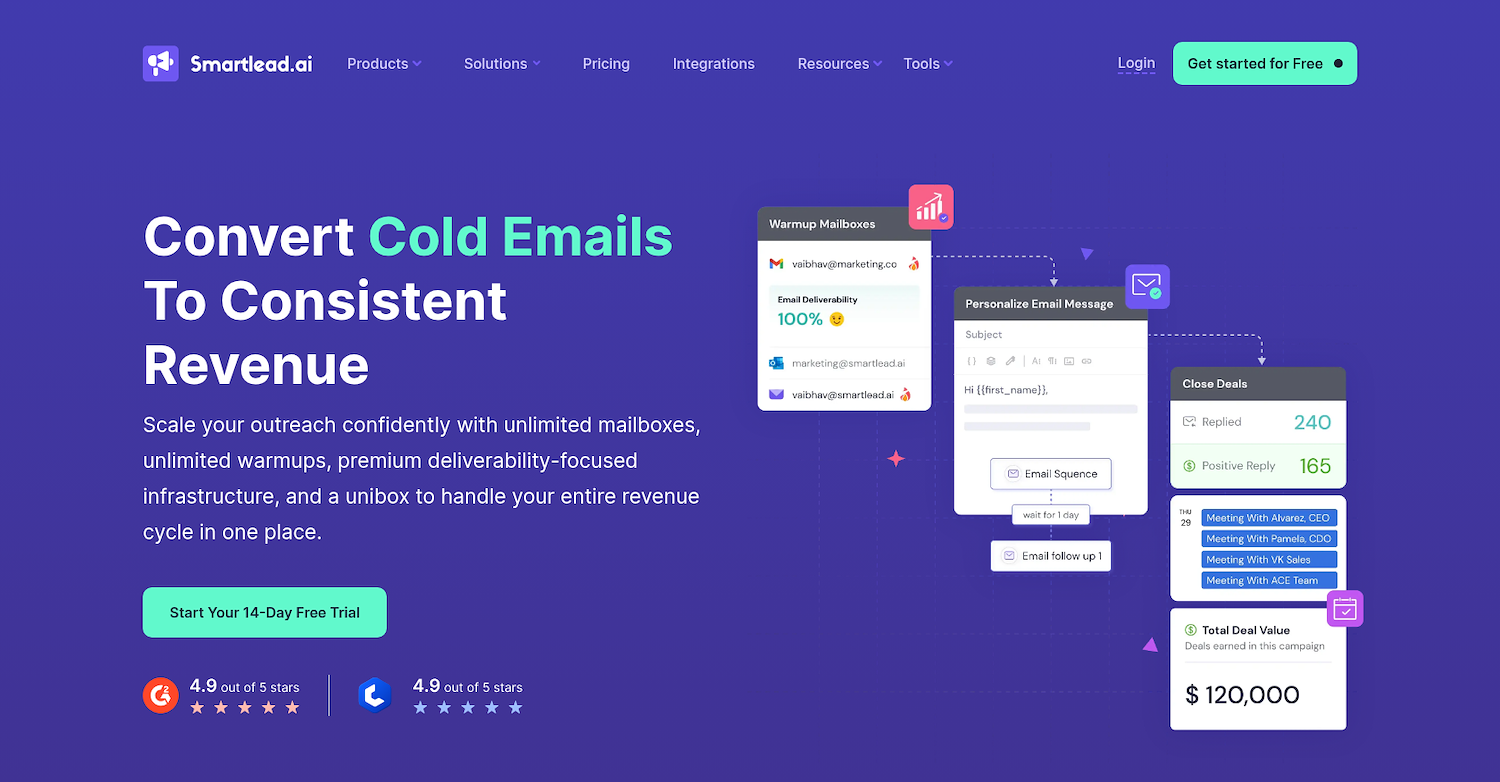
Smartlead.ai is a cold email platform that automates outreach with unlimited sender accounts. It includes an email warmup tool and a central inbox to manage all replies. The system allows for message personalization across large campaigns.
Its main uses are sales outreach, public relations, and agency client management. The platform helps teams connect with prospects through automated sequences.
Smartlead.ai's Main Features
- Offers integration APIs to build custom connections with other tools.
- Provides an email and mobile preview to check campaign appearance across devices.
- Supports high-volume sending to manage large-scale outreach campaigns.
- Includes A/B testing to compare different email versions for better results.
Smartlead.ai vs. Mails.ai: Key Differences
Average Review score: 4.6/5 stars based on 256 G2 reviews.
- Smartlead.ai supports a multi-channel infrastructure, which is different from Mails.ai's focus on email-only outreach.
- The platform includes a unified inbox to manage the entire deal flow, a broader function than the reply management inbox in Mails.ai.
- It offers agency-grade views that can be personalized for clients and teams, allowing for more specific campaign organization than Mails.ai provides.
- This tool has built-in team collaboration features like task assignments and lead-specific notes, which are not part of Mails.ai's core functions.
Smartlead.ai's Drawbacks Compared to Mails.ai
- Smartlead.ai bases its pricing on the number of active leads, which can be a constraint for large campaigns. Its entry plan limits users to 2,000 contacts, which may be less flexible than Mails.ai's model for scaling outreach.
- Its interface, built for multi-channel outreach and agency management, might feel complex for some users. This is different from Mails.ai, which offers a more specialized experience focused only on email campaigns.
- Some users report that the reporting features could offer more customization. Teams that need deep analytics might find Mails.ai's focus on email-specific metrics more direct for their needs.
Pricing and Cost-Effectiveness
Mails.ai's paid plans start at $24 per month, while Smartlead.ai's begin at $39 for 2,000 active leads monthly. Mails.ai's flat fee is cost-effective for large lists, whereas Smartlead.ai's lead-based model may suit smaller campaigns. For current pricing, visit Smartlead.ai's official website.
10) Snov.io

Snov.io is a sales automation platform for cold outreach. It provides tools to find and verify professional emails. Teams use the system to build contact lists and run automated drip campaigns to support lead generation and sales development efforts from a single workspace.
Snov.io's Main Features
- Manages contacts, accounts, opportunities, and pipelines for sales automation.
- Provides contact, company, and industry research data for lead intelligence.
- Automates lead management and marketing tasks within the platform.
- Offers reporting and analytics through customizable dashboards.
Snov.io vs. Mails.ai: Key Differences
Average Review score: 4.6/5 stars based on 450 G2 reviews.
- Snov.io provides built-in CRM tools for pipeline and opportunity management, offering a broader sales function compared to Mails.ai's focus on email outreach.
- The platform offers lead intelligence with contact and company data, a feature Mails.ai does not have, as it requires users to supply their own prospect lists.
- This tool automates lead management and marketing tasks directly on its platform, which is different from Mails.ai, where automation is built for sending email campaigns.
- It features customizable dashboards for reporting and analytics, providing a broader view of sales activities, while Mails.ai's analytics focus on email campaign performance.
Snov.io's Drawbacks Compared to Mails.ai
- Snov.io's credit-based pricing can become expensive for large-scale outreach. In contrast, Mails.ai offers unlimited inboxes, a feature that allows for more predictable costs as campaigns grow.
- The platform combines many tools like a CRM and an email finder. Some users may find this all-in-one system complex if they only need a dedicated tool for email outreach. Mails.ai offers a more focused experience.
- Its email warm-up feature is tied to the platform's credit system, which may limit high-volume use. This is different from Mails.ai, where unlimited warm-up is a core function that helps protect sender reputation.
Pricing and Cost-Effectiveness
Mails.ai's paid plans start at $24 per month, while Snov.io's Starter plan is $39 per month. Mails.ai is more cost-effective for large-scale outreach with its unlimited inboxes. Snov.io's price reflects its all-in-one approach, which includes CRM and email-finding tools in a credit-based system.
Which One Should You Go With?
There are many variables to consider when choosing a Mails.ai alternative. This guide shared several options to help you decide.
If your sales team needs digital workers for outreach and lead generation, 11x offers a focused solution. The platform is built to manage specific sales tasks on its own.




